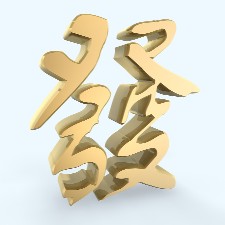The I Ching – A History
Fun Trivia, History Trivia The I Ching, also called the Book of Changes, originated during an important time in Chinese history – the overthrow of the Shang dynasty by the Chou dynasty, which also collapsed. It was a time of much social unrest and confusion. The wise men and women of the time made up stories that they fashioned into an oracle to help the people deal with all the changes.
The I Ching, also called the Book of Changes, originated during an important time in Chinese history – the overthrow of the Shang dynasty by the Chou dynasty, which also collapsed. It was a time of much social unrest and confusion. The wise men and women of the time made up stories that they fashioned into an oracle to help the people deal with all the changes.
The original stories were not all written down; many were oral. But as the chaos settled down the stories were collected and organized into a book, called at first the I Chou and later the I Ching. This book has been used continuously in China since that time.
The I Ching made its way to the West in the early part of the 20th century through the efforts of a Protestant missionary named Richard Wilhelm. Wilhelm, who had spent many years in China, had seen other translations of the book. However, they didn’t seem to reflect the way the Chinese were using the original version, so he decided to do his own translation.
Wilhelm translated the book into German and published it in the early 1920s. It went largely unnoticed until it was discovered by the psychologist Carl Jung. Jung had become interested in topics that might today be called metaphysical, and Wilhelm’s translation of the ancient Chinese stories fascinated him. He commissioned an associate, Cary Baynes, to translate Wilhelm’s German version into English. Baynes’ English translation was published in 1952, and included a foreword by Jung.
Although it’s still considered the definitive English version of the I Ching, Baynes’ work can be difficult to understand, for several reasons. For one, it’s a translation of a translation. It’s also a very large book, running more than 1,000 pages, with a structure that can be very hard to follow. And because it’s a direct translation rather than an interpretation, it closely reflects the society and culture it came from – that of the Chinese. The fact that the culture in question is 2,000 years old makes it that much harder to work with.
Several authors, though, have recently taken it upon themselves to publish their own versions of the I Ching, re-interpreting it in an effort to make it easier to use. These books range from modernized versions of the original meanings to complete reworkings, with meanings applied to specific topics like women’s issues, relationships, jobs, health, and spirituality. Some authors have even come up with their own ways to draw the hexagrams on which the I Ching is based, in order to make them simpler and faster for today’s harried Westerner.
All these efforts, of course, change the wording of the traditional I Ching. And in some cases they change the way it’s used. But do they remain true to its spirit, and to its original purpose – to provide guidance for people in times of change?
That is a question that only its users can answer.
